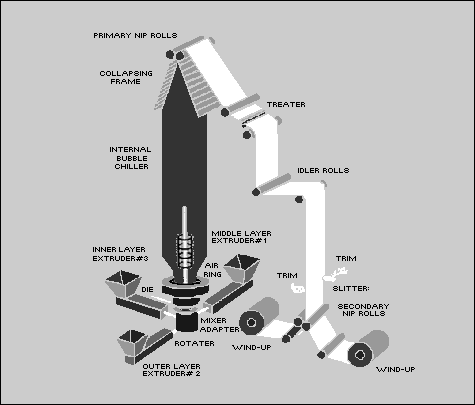





Note: The following index list will take you to separate articles pertaining to the specific subject.
return to Plastic Information and Processes
Introduction:
Converters use two methods of coextrusion: blown and flat cast. This method of producing plastic films is used for a wide verity of products. Ex.: retail bags, stretch wrap, industrial liners, shipping sacks, shrink wrap, garment bags, trash bags, photographic films, agricultural film and magnetic tape, plus many more applications.
The plastic used in a blown coextruder must be of sufficient viscosity to support its shape until it is cooled into a solid film. Overall systems must be tall enough to quench the material so that it is relatively cool before pinching it together in the primary nip rolls. In some cases, this tower is three stories tall.
Although most thermoplastic resins can be extrusion-blow-molded, the most widely used are the polyethylene's, polypropylene, and PVC.
Process:
The melt emerges from a circular die, as it rises, cool air quenches the melt to solidify it. The cool air that quenches the film comes out of an "air ring" which surrounds the die. At the top a collapsing frame collapses the tube. Trapped air inside the tube determines how wide the tube will expand as the plastic comes out of the die.

![]() Return to the Enginnering Resource Center Home Page. (ERC)
Return to the Enginnering Resource Center Home Page. (ERC)